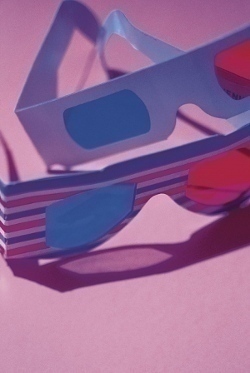Stereoscopy
Stereoscopy refers to any technique that creates the illusion of depth in an image or recording 3D visual information. The term stereo originates from the Greek word that means “relating to space” and traditionally refers to audio. In the modern sense, stereoscopy is associated with stereoscopic pictures that are photographed or drawn. It has evolved to include video games and film, but “3D” has supplanted it where stereoscopic video or imagery is concerned.
Cues Used in Stereoscopic Vision
The human brain uses a number of cues in order to view the world with depth perception. These include: the focus of the eyes, changes in the detectable size of textured patterns, linear perspective of parallel edges, the vertical position of the object being perceived, the occlusion of disparate objects, visual haze and desaturation, and the visual view angle of objects of known size. Many of these visual cues are also present in 2D imagery, but results in the enhancement of the illusion of depth in a video, game, photograph, or other 2D image when put together.
How is Stereoscopy Used in Industry?
Stereoscopy is used in photography, cinema, and the gaming industry today primarily through the production of stereograms. It is used to view various images that are created or rendered from multi-dimensional data sets captured from motion capture technology and other animation techniques. In order to provide a depth perception illusion, a computer must reconstruct two or more images, thereby creating pictures corresponding to visual pixels in the right and left images. Current research in the field of stereoscopy is focused on solving the correspondence problem in computer vision in order to suitably reproduce the stereoscopic capability from two or more images in the field of robotics.
History of Stereographic Photography
Modern stereoscopy has its origins in landscape imagery from the mid 1800s. In 1856, these images were taken with a twin lens camera that created a three dimension effect when the images were viewed with a stereoscope. English scientist Charles Wheatstone, who created a mirror stereoscope that was not usable with photography, first wrote about the practice in 1832. Scottish scientist, Sr David Brewster, improved this invention with a simplified stereo viewing instrument first exhibited in 1851. Soon after, stereoscopic photography became popular in the United Kingdom and the United States through the 1920s. It later gained popularity in cinemas (basic 3D movies) and has since evolved to being used in the cinema and video game industries.
Types of 3D Viewers
There are currently two categories of 3D or stereoscopic viewers in use today: active and passive viewers. An active viewer uses electronics that interact with the display by using various technologies to augment the display. These can be combined with 3D glasses or 3D display manipulation. Passive viewers have primarily consisted of 3D glasses that manipulate two images that are superimposed onto the same view.


Comments - No Responses to “Stereoscopy”
Sorry but comments are closed at this time.